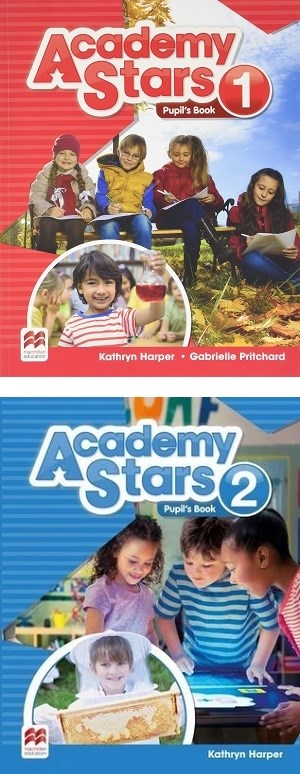Academy Stars (Levels 1 and 2), Macmillan Education 2017
 Academy Stars (Levels 1 and 2)
Academy Stars (Levels 1 and 2)
Susan Clarke and Kathryn Harper 2017
Macmillan Education
There are so many ‘Young Learner’ courses these days it’s difficult to know which one to adopt.
At first sight, Academy Stars, a new seven-level British English primary series, seems much like the rest with its focus on developing language skills and commonly shared values. However, once you get into it and use the various add-ons, it becomes clear that extra attention has been paid to the difficult task of turning children into confident learners. There is regular focus on ‘learning how to learn’ and self-reflection activities (‘be a star’) to raise pupils’ awareness of what they can do with the new language. As a primary-trained school teacher, I have always been a great fan of activities that provide the learner with an opportunity to notice what they have achieved through effort and so create ‘a growth mindset’, as Dweck (2006) calls it.
I think it’s true that much of our work in the classroom is underpinned more by feelings or assumptions of what would work best than evidence-based research. Zull (2002) and Willingham (2009) believe that evidence-based research would help teachers make learning more effective, and one strong point of Academy Stars is that the authors have taken note of research findings coming out of educational cognitive psychology.
One aspect that really stands out is the visual way grammar is presented through so-called Graphic Grammar. The approach to teaching grammar is not particularly novel: language is presented rather than discovered, even at higher levels, and then practised, both in a semi-controlled way and in a personalised production activity. However, the way the new language is presented will surely engage young learners. There’s a video for each grammar point in which one of the characters and his toy companion, Bot (a robot), experience a situation to illustrate the meaning visually. At the end of each clip the target language, which students can also see in their book, is highlighted and the patterns reinforced through colour-coded building blocks. The main verbs are blue, adjectives are green and negating words are red. I know this is something most of us like to do on the board but showing a video animation makes the meaning far more memorable for young learners. The creative teacher could use the video flexibly and provide prediction questions and vocabulary tasks and make it even more engaging.
The videos are available in the Pupil’s Resource Centre, an online practice kit of interactive activities. At higher levels, you could ‘flip’ the lesson so that pupils log on at home and watch the video before class, allowing you to focus on checking meaning and providing practice in the classroom. The Resource Centre also includes a guide to help parents gain some understanding of the approaches followed, though a concern in my current teaching context is that the guide is only provided in English, which is not very helpful for most parents because of their limited understanding.
Each unit is built around familiar topics – family, weather, etc. New vocabulary is followed by grammar, reading, listening and speaking with a focus on functional language and writing. However, one of the course’s plus points is that the content in the units is slightly different from what I’d expected. For example, in Level 2, the unit on food does not just look at what we eat, but considers how and where it comes from, providing opportunities for cross-curricular work. The unit on transport addresses how we travel, but also deals with travel safety. The approach throughout is explicitly ‘academic’, with a focus on developing problem-solving skills, critical thinking and independent learning strategies.
I was pleased that phonics was included at the lower levels. For my current context, working with Arabic speaking learners, this is invaluable, as my pupils struggle with spelling and reading, and need strategies to deal with them.
All learners will benefit from the indepth focus on reading. Each unit has two reading texts to consolidate the target language. In addition, each level contains three or four more extensive readings in a section called Reading Time, which consist of age-relevant written genres (e.g. Unit 5 in Level 1 has a story about a tiger and a fox). The accompanying video allows lowerlevel learners to watch or read and listen, and for higher-level learners the different story endings will generate some interesting discussions. And if you need more ideas, there are worksheets to download on the online Teacher Resource Centre!
Also online, there are flashcards for the lower levels, assessment materials, and an in-depth methodology guide for teachers about the what and how of graphic grammar and the extensive reading sections. Everything is downloadable per section, so you don’t need to install it on your computer, which is great for my always full computer. The main issue, and this might not be of any concern in your context, is that all the online resources other than the audio, which is available on CD, do need to be downloaded, which has proven to be an issue where networks are slow. Personally, I’d rather have the option of being able to buy a DVD-ROM with all the resources on.
So far, Academy Stars has been well received in my school. If you are looking for a holistic approach which establishes lifelong learning skills and builds learner confidence, I’d definitely check it out.
References
Dweck CS (2006) Mindset: The New Psychology of Success. Random House Publishing Group.
Willingham DT (2009) Why Students Don’t Like School. Jossey-Bass.
Zull JE (2002) The Art of Changing the Brain. Stylus Publishing.
Comments
Write a Comment
Comment Submitted